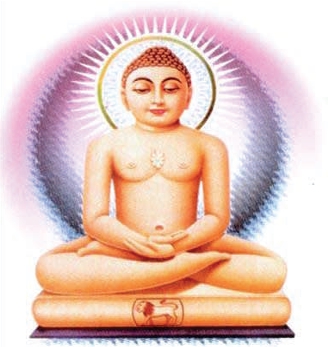
History of Jainism in Karnataka (I)
According to Jaina traditions, Jainism in Karnataka goes as back as Vardhamana Mahavira (vardhamāna mahāvīra). Jīvandhara, one of the popular saints of Jainism, hailed from Karnataka and was initiated by Mahavira himself. A very strong (Digambara) tradition is found in the story of Acharya Bhadra-bahu (ācārya bhadra-bāhu) coming to Shravana-belgola (śravaṇa-beḷgoḷa) in the company of Chandra-gupta Maurya and staying there. According to this tradition, the disciples of Bhadra-bahu propagated the religion all over Karnataka and other parts of South India. Only as late as 6-7th century A.D. an inscriptional evidence is found to support this belief, wherein the name of the king is given as Prabhā-candra. This tradition is very strongly reflected in the literature of the Kannada Jainas.
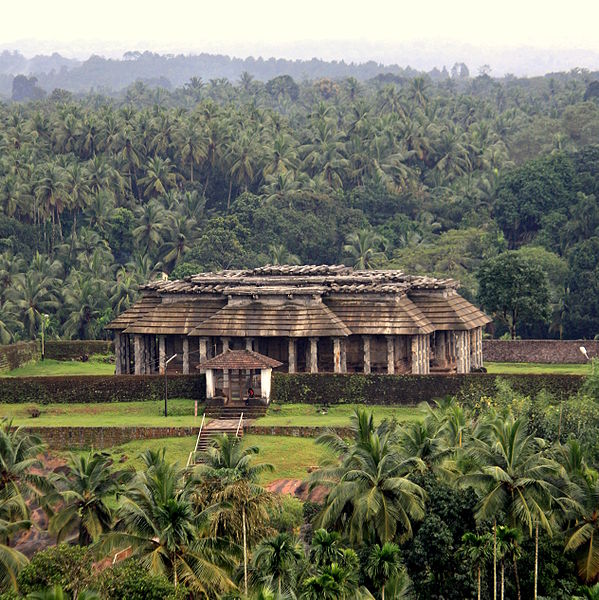 |
Caturmukha basadi, Karkala (Udupi district), 1432/1586 CE. |
The earliest of dynasties in South Karnataka, the Ganga (gaṅga) lineage, according to tradition, was founded with the blessings of the Jaina sage, Simha-nandi. This event might have taken place during the early centuries of the Christian era and the dynasty is supposed to have continued till the beginning of the 11th century A.D.
Some of the Ganga kings were devout Jainas and each one of them was tolerant to all religions. Many of the Jaina sages and scholars lived peacefully during the Ganga period. Cāmuṇḍa-rāya, the famous general of Ganga Rāca-malla, erected the wonderful monolith of Śravaṇa-beḷgoḷa, the Bahu-bali idol, in A.D. 981. The Cāmuṇḍa-rāya-basadi in this tirtha (tīrtha; holy place) was constructed by the same Ganga general. Numerous are the basadis constructed during the time of the Gangas in tirthas like Shravana-belgola, Kambada-haḷḷi and Manne.
In the north of Karnataka, the Kadambas were ruling (A.D. 345-565) from Bana-vasi (bana-vāsi). They were Brahmins, but showed interest in the promotion of Jaina religion. The Kadamba king, Ravi-varma (538-50 A.D.), used to take the advice of a Jaina scholar, Kumāra-datta. He produced an ordinance instructing people to collect things for the celebration of the Jinēndra festival in the month of Kārtikā. The famous basadis at Halsi and Bana-vasi (these two places were their capitals) were built during the Kadamba rule.
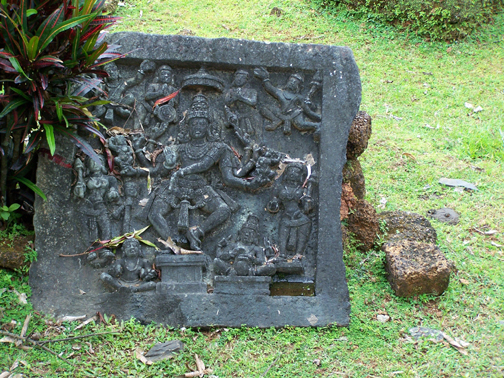 |
Bas-relief of a dancing god, Padmavati Temple, Humcha. |
The Chalukyas (cāḷukya) of Badami (bādāmi; 5th-8th centuries A.D.) witnessed the erection of the rock-cut temples in Aihōḷe, Badami and Mēguḍi. Royal grants to Jaina institutions and personae are mentioned in inscriptions. Vinayāditya (A.D. 696-733/4) donated land to a Jaina ascetic of Mūla saṅgha. Similarly, his successor, Vijayāditya, gave away the village of Seribaluru near Lakṣmēśvara to Jaya-dēva-Paṇḍita for worship in the Śaṅkha-Jinālaya.
The Rashtrakuta (rāṣṭrakūṭa) period (8th-10th centuries A.D.) was very favourable for the growth of Jainism. Basadis were erected in places like Paṭṭadakal, Honnūr, Nāmagal etc. The Jaina scholars received active encouragement at the hands of the Rashtrakuta kings, viz., Danti-durga (c. A.D. 752-56), Amoghavarsha I (814-80 A.D.) and Krishna II (880-915 A.D). Of these, Amghavarsha was a stalwart of Jainism. He felt that even the remembrance of his guru, Jinasēna, would purify him. It is supposed that he was an ardent follower of the Syād-vāda philosophy. Another Rashtrakuta king, Indra III, got made a pedestal for the abhiṣeka of Śāntinātha. According to Altekar, one third of the Kannada population was Jaina during the time of the Rashtrakutas.
Chalukyas of Kalyana extended their patronage to Jainism. They made grants to basadis and patronized Jaina ascetics. It was during their reign (963-1184 A.D.) that the numerous Jaina basadis in the South Maharashtra areas came up.
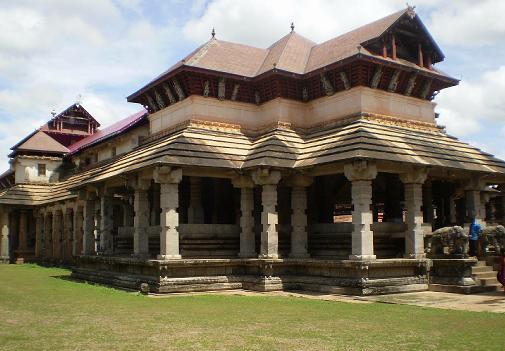 |
Tribhuvana Tilaka Chudamani Basadi, Mudbidri (Dakshina Kannada District), 1430 CE. |
Abundant Jaina monuments and inscriptions belonging to the Hoysala (hōysaḷa) period, bear witness to their patronage to Jainism. Ereyanga (A.D. 1063-1100), the Hoysala king, is said to have made many grants for worship in various shrines, food and vessels in Shravana-belgola. It was during the time of Hoysala Vishnuvardhana (viṣṇuvardhana; A.D. 1100-52) that Jainism had its hey-day in Karnataka. His queen, Santale (śāntale), was a devout Jaina and got constructed a number of basadis. There is an opinion that this monarch had, in his later life, become a staunch supporter of Vaishnavism and had persecuted Jainas and demolished many Jaina temples. But epigraphical evidences show that he respected Jainism and patronized it. Nara-simha I (A.D. 1152-73) was a Vaishnavite but he had much respect for Jainism. He visited Shravana-belgola in A.D. 1159 and made grants to Jinālaya built by his minister Hulla (huḷḷa).
It has to be mentioned here that many of the feudatories of the Hoysalas were Jainas by profession. The Santaras (sāntara) are good examples. Bhuja-balaSantara, one of the chiefs of this dynasty, caused a Jaina temple to be constructed in his capital, Hombuja, which he handed over to Kanaka-nandi-dēva with a village in A.D. 1061. The Seuna kings had Jaina raja-gurus (rāja-guru; royal teacher), though they were not Jainas themselves. They made grants to Jaina establishments. Simghaṇa, one of the kings of this dynasty, made donations to the Jinālaya in Purikere-nagara, for the worship of Pārśvanātha and made grants to the temple of Ananta-tirthankara-Jina-bhattaraka (ananta-tīrthaṅkara-jina-bhaṭṭāraka). Jina-bhattaraka was the Raja-guru of Rāma-candra.
In the 12th century A.D., we find that a number of minor dynasties in the coastal Karnataka were giving a thrust for the prosperity of Jainism. They were supported by the Vijaya-nagara kings also. The Bhairarasa-Wodeyars of Kalasa-Karkalala (kalasa-kārkala), the Chautas of Puttige, the Ajilars of Venuru (vēṇūru), the Samantas (sāmanta) of Simantur, the Saluvas (sāluva) of Sangita-pura (sangīta-pura) and Gerasoppe, the chiefs of Bilige etc., actively played their roles in the promotion of this religion. These chiefs constructed Jaina monuments in places like Karkalala (kārkaḷa), Varanga (varāṅga), Guruvāyan-kere, Venuru, Mudubidire (mūḍubidire), Hāḍu-vaḷḷi, Honnāvara, Bhaṭkal, Gerasoppe etc. Jainism was immortalized by Pāṇḍyappa of Kalasa-Karkalala (A.D. 1432) and Timmaṇṇa Ajilar of Venuru (A.D. 1604) by erecting Gommaṭa statues in their respective places.
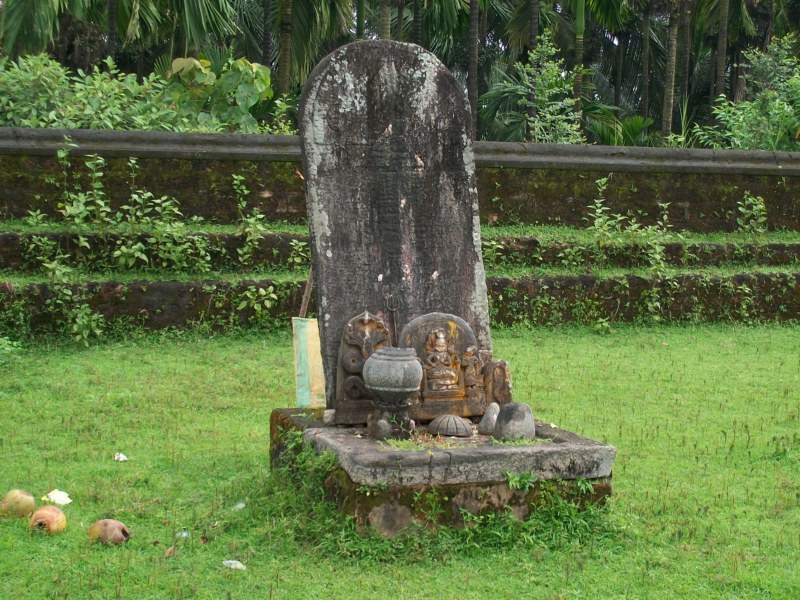 |
Kshetrapala near Rishabhanatha temple of Kulla basadi complex, Venur (Dakshina Kannada District). |
Another noteworthy event in the history of Jainism in Karnataka is the number of royal ladies who were pious Jainas and obedient disciples of their respective preceptors. These ladies have donated generously for the cause of Jainism. Santale, the queen of Hoysala Vishnuvardhana, is the foremost among them. In almost every dynasty, we find such pious and generous ladies. Female householders do not lag behind. The inscriptions mention hundreds of names of such ladies who led a pious life, donated generously and died, in many cases, observing sallēkhanā. Dāna-cintāmaṇi Attimabbe comes to the mind of every one who thinks about the Jaina women of Karnataka.
 P.M. Joseph
P.M. Joseph